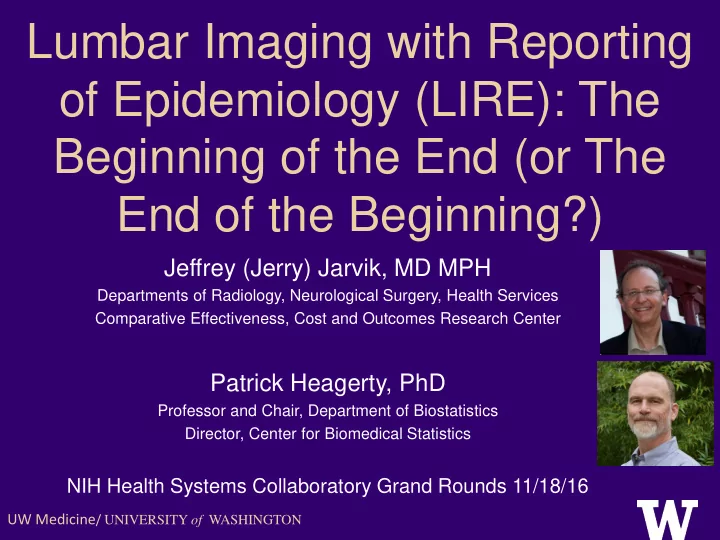

Lumbar Imaging with Reporting of Epidemiology (LIRE): The Beginning of the End (or The End of the Beginning?) Jeffrey (Jerry) Jarvik, MD MPH Departments of Radiology, Neurological Surgery, Health Services Comparative Effectiveness, Cost and Outcomes Research Center Patrick Heagerty, PhD Professor and Chair, Department of Biostatistics Director, Center for Biomedical Statistics NIH Health Systems Collaboratory Grand Rounds 11/18/16 UW Medicine / UNIVERSITY of WASHINGTON
Acknowledgements • NIH: UH2 AT00776 6-01; UH3 AT007766 • AHRQ: R01HS019222-01; 1R01HS022972-01 • PCORI: CE-12-11-4469 Disclosures (Jarvik) • Physiosonix (ultrasound company) – Founder/stockholder • Healthhelp (utilization review) – Consultant • Evidence-Based Neuroimaging Diagnosis and Treatment (Springer) – Co-Editor
Talk Outline • Brief review of study goals/design • Progress to date • NLP for data extraction from radiology reports • Next steps
LIRE (pronounced leer)- From the French verb, “To Read”
Background and Rationale • Lumbar spine imaging frequently reveals incidental findings • These findings may have an adverse effect on: – Subsequent healthcare utilization – Pt health related quality of life
Disc Degeneration in Asx
Hypothesis • For pts referred from primary care, inserting prevalence benchmark data in lumbar spine imaging reports will reduce: – subsequent x-sectional imaging (MR/CT) – opioid prescriptions – spinal injections – surgery
Retrospective Pilot Results: Subsequent Imaging Within 1 Yr 12/166 P=0.14 OR*=0.22 1/71 * Adjusted for imaging severity
Retrospective Pilot Results: Narcotic Rx Within 1 Yr P=0.01 37/166 OR*=0.29 5/71
Intervention Text The following findings are so common in normal, pain-free volunteers, that while we report their presence, they must be interpreted with caution and in the context of the clinical situation. Among people between the age of 40 and 60 years, who do not have back pain, a plain film x-ray will find that about: • 8 in 10 have disk degeneration • 6 in 10 have disk height loss Note that even 3 in 10 means that the finding is quite common in people without back pain.
Randomization • Cluster (clinic) • Stepped wedge (one way crossover)
Participating Systems Name # Primary # Primary Care # PCPs # PCPs Care Clinics (Original) (Randomized) Clinics (Randomized) (Original) Kaiser Perm. 17 21 1,006 2,243 N. California Henry Ford 26 26 230 187 Health System, MI Group Health 25 19 303 365 Coop of Puget Sound Mayo Health 61 34 269 400 System Total 129 100 1808 3,195
Stepped Wedge RCT 1/13 1/14 1/15 1/16 1/17
LIRE- The Outcome • A single metric of overall intensity of resource utilization for spine care based on CPTs converted to RVUs • Passively collected from EHR
Key Pragmatic Aspects of LIRE • Broad inclusion criteria • Waiver of consent • Centralization of IRB review • Simple, easily implemented intervention • Passive collection of outcomes • Cluster randomization • Stepped wedge randomization
LIRE PRECIS
Talk Outline • Brief review of study goals/design • Progress to date • NLP for data extraction from radiology reports • Next steps
LIRE: Enrollment
Demographics
Patient age at index image
Female
Race
Hispanic Ethnicity
Imaging Modality
Recommend
More recommend